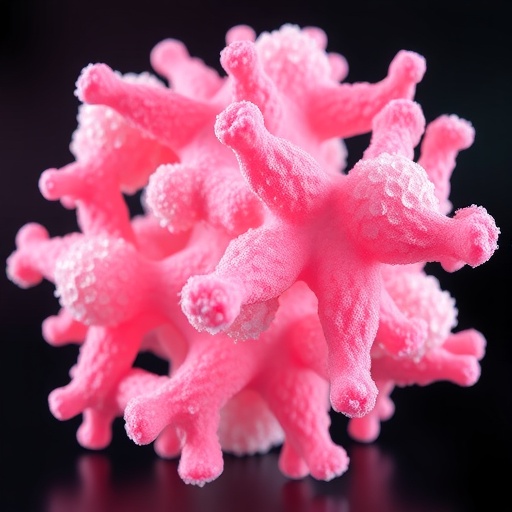A groundbreaking advance in the field of structural biology has emerged from the Institute of Science Tokyo, where researchers have developed an innovative, rapid, and purification-free technique for elucidating detailed three-dimensional structures of flexible sugar molecules. Sugars, or saccharides, which play far more complex and critical roles in biological systems than their common association with sweetness suggests, have long posed formidable challenges to structural characterization due to their inherent flexibility and dynamic conformations. This pioneering method leverages cell-free protein crystallization (CFPC) of galectin-10 (Gal-10), a sugar-binding lectin, to create molecular crystals capable of capturing and stabilizing sugar molecules, enabling unprecedented high-resolution analysis of their atomic arrangements through X-ray crystallography.
In living organisms, carbohydrates serve as crucial mediators of cell-cell communication, infection control, and tissue regeneration. They embellish cell surfaces, creating a dynamic molecular interface crucial for countless physiological processes. Decoding how these sugar molecules fold and interact with proteins is vital to understanding their biological functions. However, their flexible nature has historically thwarted efforts to obtain precise structural insights, as conventional crystallographic and spectroscopic techniques often falter when confronted with molecular heterogeneity and rapid conformational change.
Addressing these challenges, Professor Takafumi Ueno and his team at the Institute of Science Tokyo conceived a strategy that bypasses purification bottlenecks by directly synthesizing crystals of Gal-10 through CFPC—a method where protein crystallization occurs in vitro without the need for living cells. This cell-free approach significantly accelerates the crystallization process, enabling crystal formation within a single day. Critically, these Gal-10 crystals serve as a molecular scaffold that entraps sugar molecules within their network, permitting the structural analysis of sugars in their bound states.
The researchers capitalized on the sugar-binding specificity of Gal-10 by soaking the pre-formed crystals in solutions containing different natural sugars. This soaking enabled the sugars to infiltrate the crystal lattice and adopt conformations stabilized by interactions with the lectin. Through this technique, the team achieved the first-ever atomic-resolution imaging of melezitose, a particularly flexible trisaccharide notoriously difficult to characterize with prior methods. Likewise, raffinose, a prebiotic sugar known for its beneficial effects on gut microbiota, was structurally elucidated with remarkable detail.
An intriguing facet of their research involved exploring how alterations in the Gal-10 protein affected sugar binding. By introducing a point mutation—substituting glutamic acid at position 33 with alanine (E33A)—the authors engineered a variant of Gal-10 that more snugly accommodated sugar molecules in its binding pockets. This mutation revealed the exquisite sensitivity of sugar-protein interactions to small changes in amino acid composition, providing valuable insights into molecular recognition processes.
Professor Ueno emphasizes that this rapid visualization capability is revolutionary for glycobiology. Traditional methods often require extensive purification steps and long crystallization times, whereas this approach facilitates real-time observation of sugar conformation dynamics and binding events. Such direct structural snapshots empower researchers to interrogate the interplay between flexible sugars and their protein partners with unprecedented precision, shedding light on fundamental biological mechanisms.
To enhance their understanding of the dynamic nature of sugar movements within the Gal-10 crystals, the team combined high-resolution X-ray crystallographic data with molecular dynamics simulations. This integrative computational-experimental approach illuminated how the crystal environment restricts sugar flexibility, maintaining them in defined conformations suitable for imaging. Moreover, simulation results revealed how subtle shifts in sugar molecular geometry influence the strength and specificity of sugar-protein interactions—a finding with significant implications for rational drug design targeting carbohydrate recognition pathways.
This CFPC-Gal-10 platform lays the groundwork for high-throughput analysis of complex carbohydrates. Its speed and precision herald a paradigm shift in glycobiology research, enabling rapid screening of hundreds of sugars and related small molecules. Such capability is critical for accelerating discoveries in drug development, biomaterial engineering, and understanding disease mechanisms where carbohydrate-protein interactions play pivotal roles.
The research’s implications extend beyond basic science. Detailed structural knowledge of sugars aids in the design of therapeutic agents targeting pathogen adhesion, cancer metastasis, and immune modulation—processes intricately linked to glycan interactions. Furthermore, the study paves the way for exploring carbohydrate behavior under physiological and pathological conditions that have, until now, been intractable due to technical limitations.
By streamlining sugar structure determination without the need for labor-intensive purification or cell culture, this work not only democratizes access to complex carbohydrate structural data but also promises to accelerate innovation in multiple disciplines. The integration of CFPC and computational modeling exemplifies how multidisciplinary approaches can overcome longstanding barriers in molecular biosciences.
In summary, the team’s novel methodology, combining CFPC-grown Gal-10 crystals with sugar soaking and advanced imaging complemented by molecular dynamics, marks a significant leap forward in carbohydrate structural biology. It offers a powerful, versatile tool to unlock the secrets of sugar flexibility, protein recognition, and molecular dynamics, which are essential to advancing our understanding of life at the molecular level and harnessing this knowledge for societal benefit.
Subject of Research: Structural analysis of flexible sugar molecules using cell-free protein crystallization of galectin-10 crystals.
Article Title: Cell-Free Protein Crystallization Enables Rapid Structure Determination of Disaccharides and Trisaccharides Using Galectin-10 Crystals
News Publication Date: 23 October 2025
Web References: http://dx.doi.org/10.1002/sstr.202500501
Image Credits: Institute of Science Tokyo
Keywords: Life sciences, Biochemistry, Protein functions, Proteins




